While you’re probably spending winter indoors, rodents and other hungry animals are outside and looking for things to eat. Your trees may be their next meal.
There are a variety of animals that commonly cause winter tree damage in New Jersey and Pennsylvania; most, but not all, are rodents.
Deer also damage trees and shrubs in winter – see our article on how to prevent winter deer damage for details on dealing with them.
Who’s Eating My Trees?
In winter, the most likely rodent suspects are squirrels, gophers, and voles. Other non-rodent species, such as rabbits, also damage trees in winter.
Squirrels Cause Extensive Damage in Tree Tops
You’ll find squirrel damage above ground and higher in your tree’s crown, mostly in late winter. Squirrels can seriously injure trees by chewing and stripping bark and leaves, although they tend to strip bark mostly on branches rather than the trunk. You’ll see patches or strips of damage, or areas of missing bark that are relatively narrow (maybe ½ inch) and about 3 to 6 inches long. Also, their random fruit sampling reduces your harvest!
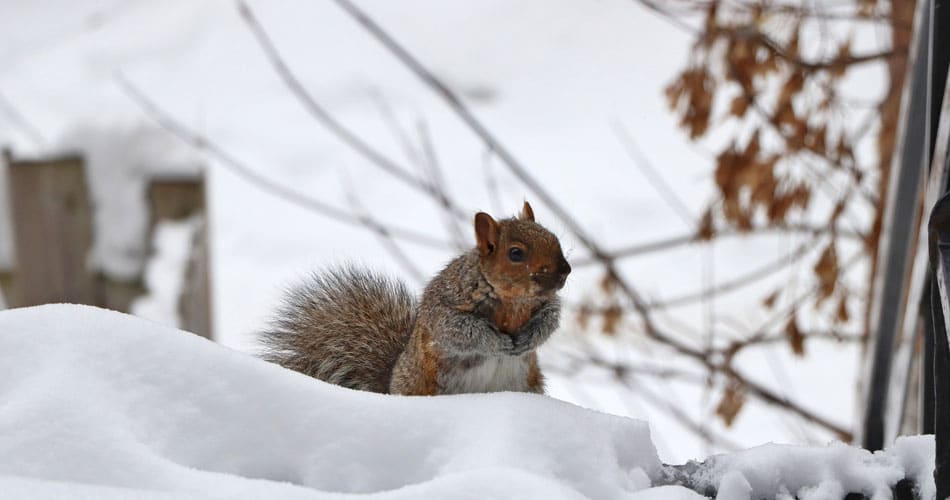
Squirrels can damage your trees above ground by removing bark to eat
Squirrel damage can girdle the trunk and branches of trees (by removing bark around the entire circumference of the trunk or branch) and leave open bark wounds. Girdling cuts off a tree’s food and water systems, meaning that a tree can’t move water or nutrients through its roots or to its branches. While trees can survive some bark stripping, they cannot survive being girdled.
Rabbits Eat Bark Above Snow Level
Rabbit damage is also found only above ground. During the winter, rabbits hop across the hardened snow to reach tree trunks where they gnaw on tree bark just above the snow level. You’ll see areas of exposed interior tree wood surrounded by normal bark growth.
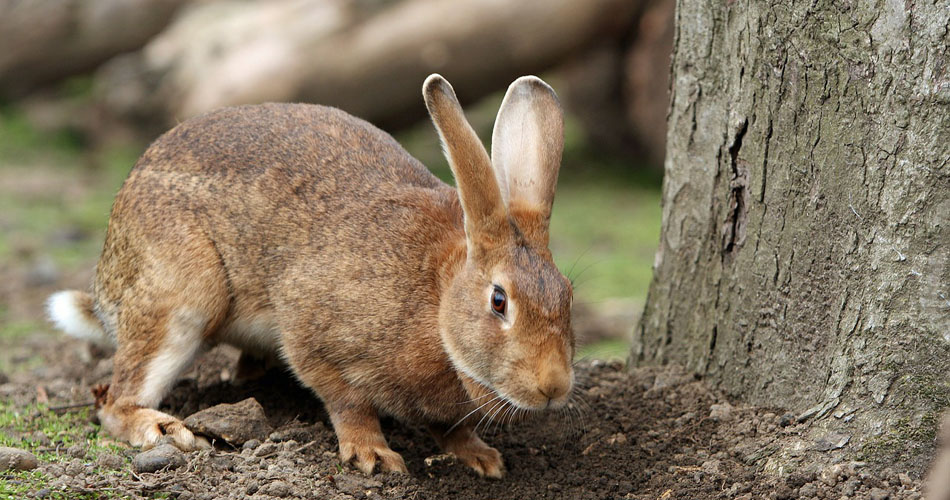
Rabbits can eat the bark of your trees
Voles & Gophers Can Kill Trees
Pennsylvania and New Jersey have two species of voles, the meadow vole and the pine vole; both species are plentiful and are active year round. Gophers are also common. Both types of rodents eat plants, including tree roots, shoots and bark (basically, whatever they can reach). Look for indented or gouged areas made by gnawing, and for areas with no bark, including girdling.
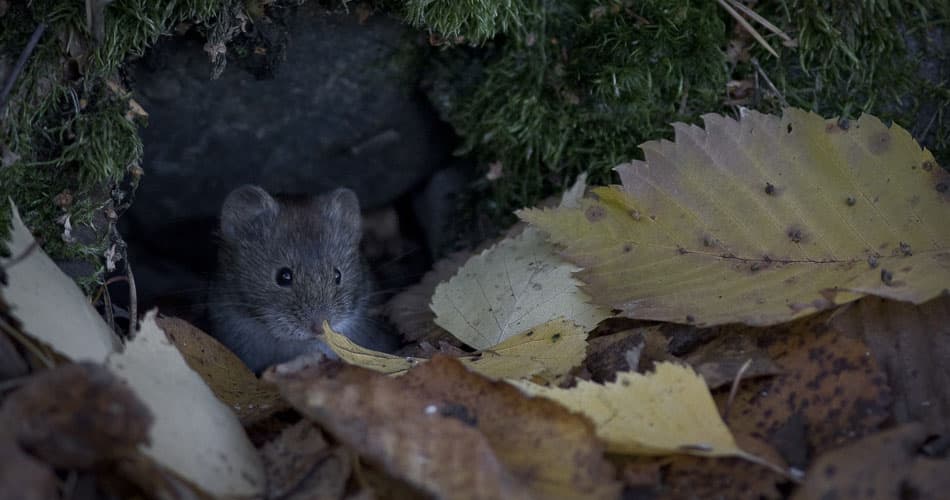
Burrowing voles can fatally injure trees
It’s these burrowing species that can do the most serious damage in winter because they remain unseen beneath the snow layer. You often won’t see evidence of their activity until the snow melts in spring. After that, it can take months for a tree’s vigor to decline from underground root system damage.
How to Identify Rodent Damage to Trees

Squirrel damage to a young sycamore tree shows bark stripped from the trunk
Rodents scrape and gnaw bark and roots with their teeth, which is especially damaging to young trees whose roots are softer and whose bark is still thin, tasty, and easy to break open.
If you find the bark has been stripped all the way around the base of a tree’s trunk, the tree has been girdled. Since girdling is usually fatal to trees, you should call in a Certified Arborist to evaluate the tree and keep an eye its growth in the coming years. You may see an overall pattern of decline, which indicates that the tree’s food and water distribution system has been fatally damaged. Girdling of this kind is most likely in young trees.
The base of a tree’s trunk is especially sensitive to rodent damage, as well as to damaging organisms and other pests. The place where bark tissue becomes root tissue is (or should be) just near the surface of your mulch. Burrowing rodents will gnaw on the bark and roots here, as well as on roots further underground. When this happens during winter under snow, you will need to dig or scrape out the snow to find evidence.
After the snow melts from around your trees, you’ll see evidence of vole or gopher activity. Gophers will leave mounds of soil at the surface around their numerous routes. If you find little surface routes of disturbed soil leading to trees or shrubs, these are most likely made by voles.
Which Trees are More Likely to be Eaten by Rodents in Winter?
Sadly, almost any tree is vulnerable. There are few species that rodents won’t try, especially when they’re hungry. Often it’s not a particular tree or shrub, but how tasty and tender its bark and roots are and how easy it is to get to them. You will probably find rodent damage where you don’t expect it. Winter means food sources are scarce, and almost all foraging animals sample whatever they come across.
How do I Prevent Winter Rodent Damage to My Trees?
Depending on the number of trees on your property, the size of the rodent population, and the surrounding environment, you have several options for minimizing rodent damage.
1. Exclusion – Keep rodents away from your trees
Wrap metal mesh or hardware cloth around your trees’ trunks to keep the critters from reaching your tree’s bark or roots.
- For voles, wrap the trunk of your trees or large shrubs with 24-inch wide wire mesh. Try to bury about six inches of it to prevent underground access. Keep the metal mesh slightly away from the trunk so it doesn’t rest right against it.
- For gophers, the hardware cloth should stand free from a tree’s root ball and be buried a foot or more into the ground, with a 90 degree bend at the base to make a shelf that prevents gophers from tunneling under.
- For rabbits, ensure that the metal mesh is above the snow line. You may need to move it upward during the winter to keep it above the snow.
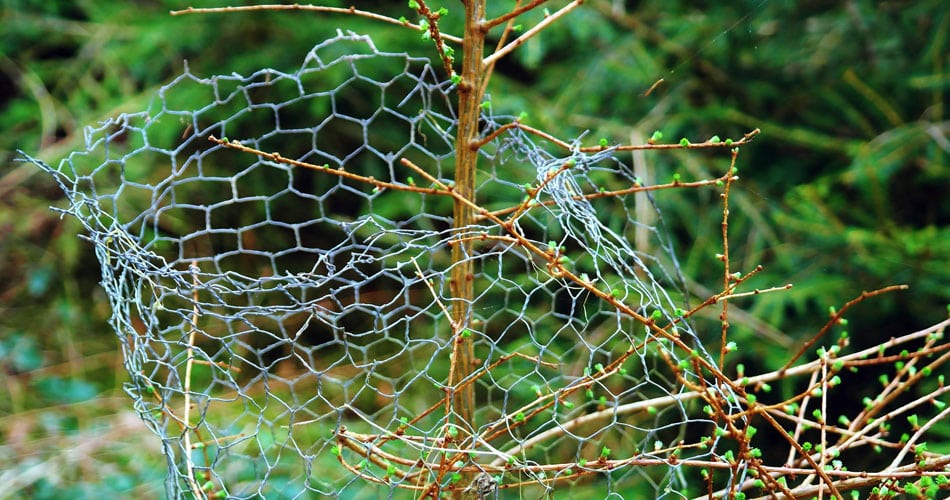
Wire mesh can keep critters from chomping on your young trees
These protective surroundings are easier to install around young trees, as older trees have pronounced trunk flare and established anchoring roots. Thankfully, these pesky critters tend to prefer the softer bark of young trees; they’re less likely to strip or eat thicker bark. Digging out and disturbing established tree roots to install hardware cloth is not recommended. If installing around young trees, be sure to invest in heavy leather gloves and sharp metal snips.
2. Habitat Modification – Make the surrounding area unappealing to rodents
Simple changes to your environment will help to both invite predators and reduce the attractiveness of your landscape to damaging rodents. Creating an environment that allows these predators to do their work may be all you need to do during the rest of the year to reduce winter rodent populations.
Rodent predators are attracted to places where rodents live, so clearing overgrowth and mowing down grasses and weeds is an easy way to force rodents into the open where predators can spot them.
Among the suggested changes to your environment are:
- Growing low, non-matting grasses instead of tall grasses
- Cutting or mowing down any tall grasses and weeds around your trees
- Planting vetch, which voles don’t like
- Shoveling snow away from trees and shrubs to allow natural predators a clear view of rodents and discourage rodents from entering the area
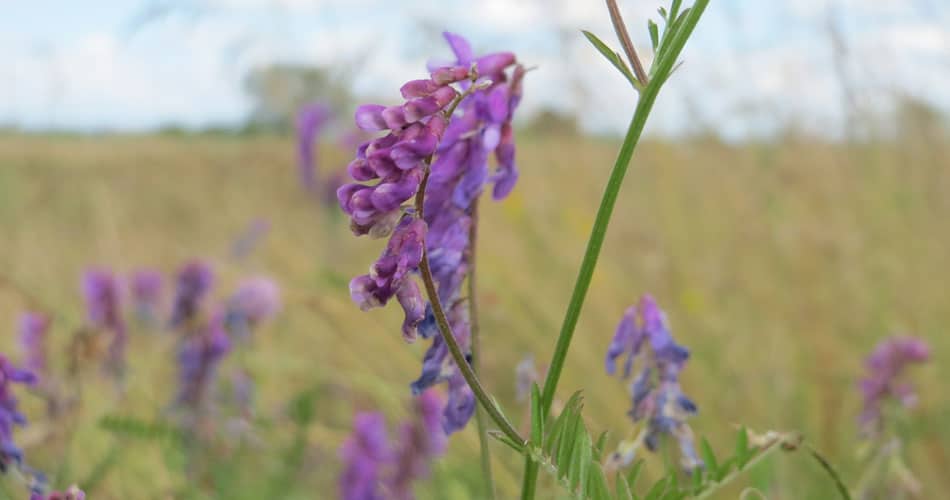
Voles don’t like vetch, so planting it in your yard might help repel them
3. Repellents – Push rodents away with substances they don’t like
Repellents and traps (see the next option) have their own benefits and shortcomings.
One option is a fungicide called Thiram that can be used as a contact repellent to keep rodents and rabbits away from trees during the dormant season. It contains a sulfide, with the sulfur odor and taste being one of its repelling components. It’s commonly sold under several trade names, including Bonide Rabbit-Deer Repellent® and Nott’s Chew-Not. Wear proper protective gear when spraying or painting it on your trees as it can cause irritation to humans and injury to pets (it’s not fatally toxic to pets but it’s best to keep them away).
Other repellents include real or synthetic animal urine, and sprays made of castor oil and the active ingredient in hot peppers.
NOTE: Unlike physical barriers, repellents need to be applied regularly and repeatedly, and their effectiveness is measured in terms of damage reduction, not elimination. You need to apply before rain arrives, and re-spray after rains or snowfall. Sprays require clear weather to dry and stick to tree bark.
4. Traps – Catch the critters before they eat your tree
You’ll need to set and place traps strategically in tunnels or burrows according to instructions, and check them daily. Gophers make a large network of tunnels and you need to follow their development to put traps in the most recently dug areas. If a baited trap is ignored, your burrowing rodents have moved on to other, new tunnel locations.
5. Predators – Invite them onto your property
For squirrels, natural predation is the best way to reduce populations. Squirrels are too numerous (you may trap one, but another will immediately appear to fill the void), and too goal-oriented to let most protection methods keep them from your delicious trees.
Rodents have predators on the ground and in the sky. Hawks, owls, snakes, foxes, coyotes and weasels are the most common. Foxes eat fruits and berries too, but mostly these predators focus on eating the insects and small mammals that you don’t want in your garden.
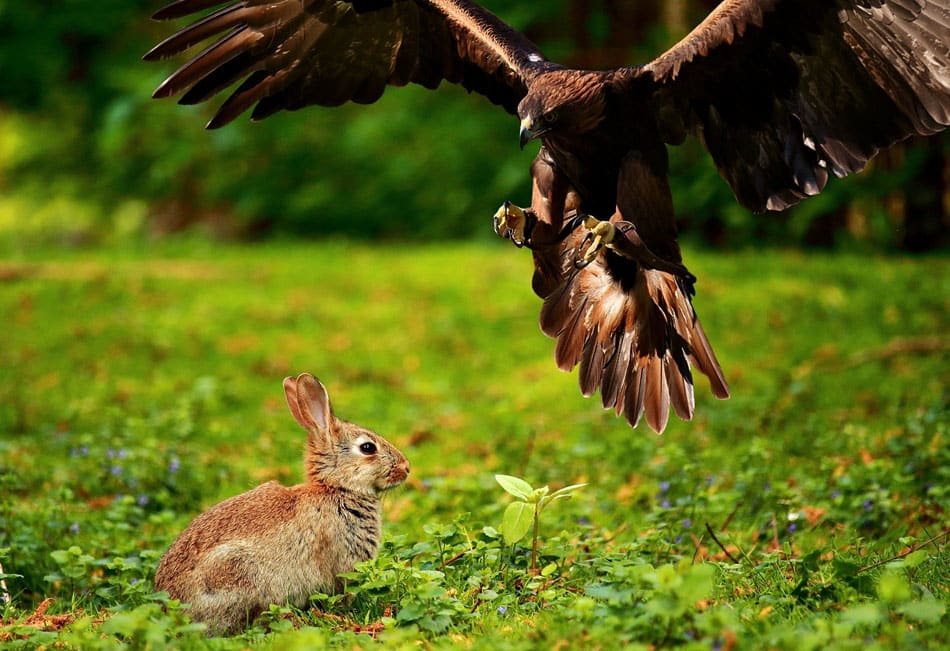
Attracting predators to your yard can help control the rodent population
Since the natural predators of squirrels are not interested in you and only one or two of all natural rodent predators might be interested in your pets, consider making your landscape inviting to these beneficial predators. If you’re worried about your pets, monitor them outdoors at night, and exercise them on leashes during the day.
What Not To Do
There are some practices we generally don’t recommend. These include:
- Spraying herbicides to remove ground cover (tree roots are sensitive to herbicides)
- Tilling soil to disrupt vole and gopher tunneling (especially if it’s within the tree’s root zone)
- Poisoning (fatal poisons used to control rodents often have effects beyond their target, including predators and pets)
A Caution About Using Rodent Poison
If you’re dealing with a large rodent population, none of the above methods of control may be sufficient. In those cases, there are various toxicants and anticoagulants on the market that can be used by a licensed professional wildlife technician. New Jersey has strict laws on the legality of particular applications and ensuring that non-target species are not injured. Don’t try to do this yourself; bring in the professionals who are experienced in the use of this particular control method.
In Summary
If you’re not sure what’s right for your garden and trees, call your local tree care specialists at Organic Plant Care. Winter rodent damage to trees and shrubs can be serious so you’ll want to prevent it as much as you can. We can advise you on the benefits and drawbacks of different control methods and recommend the options that will work best for you.
GET THE LATEST NEWS
Subscribe to the Organic Plant Care Newsletter and get timely and helpful tips and updates monthly.
There's no spam - we promise!





